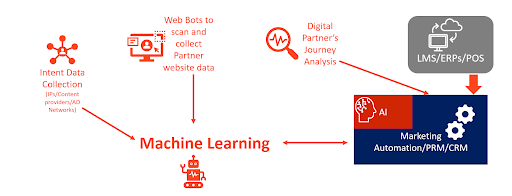
The role of AI in helping partners choose the right messaging
Next-gen partner marketing software platforms are equipped with content recommendation engines that leverage machine learning capabilities to suggest the right partner marketing and sales assets for the partners to use based on various factors such as the prospect’s persona, their position in the sales cycle.
Application of AI in text-based content generation
By integrating email marketing tools with AI-powered chat models like Chat GPT or Bard, businesses can generate relevant marketing content across various avenues. With AI-powered content authoring tools, marketers can generate high-quality content at a much faster pace, eliminating the need for extensive manual writing. The scalability offered by AI enables businesses to produce a larger volume of content across various channels, such as blogs, social media, and email marketing, thereby increasing their reach and engagement with the target audience.
Let’s learn more about Prompts, Prompt-writing and how partners/marketers can use prompts to generate the right marketing messages
Businesses utilize AI-based content authoring tools such as Bard or Chat GPT to create engaging partner marketing content by leveraging natural language processing and machine learning algorithms. One of the key elements in this context is “Prompts” and “Prompt writing”. Let’s learn more about prompts.
A prompt is a piece of text or a specific instruction given to the language model to guide its response. When interacting with an AI like ChatGPT or BARD, users provide prompts to specify the desired output or to set the context for the model’s response.
For example, if a user wants to generate a creative marketing slogan, they could provide a prompt like: “Create a catchy slogan for our new product, which is a smart home device that controls lights, temperature, and security.”
Prompts play a crucial role in the usage of ChatGPT and other language models. They serve as the starting point for the model’s responses and provide the necessary context or instruction to guide its generation.
Providing a prompt helps set the context for the language model, enabling it to understand the user’s intention or query better. The more detailed and specific the prompt, the more focused and relevant the model’s response is likely to be. For example, a user can prompt ChatGPT with the instruction, “Translate the following English text into French.” In response, the model will attempt to translate the provided text accordingly.
Prompts allow users to adapt the language AI to specific domains or tasks. By tailoring the prompts to suit a particular industry, subject, or use case, users can create custom versions of the language model with specialized knowledge.
When fine-tuning language models for specific applications, prompts are utilized to guide the training process. Data sets with prompt-response pairs can be used to fine-tune the model for improved performance on particular tasks.
Let’s learn more about Prompts, Prompt-writing and how partners/marketers can use prompts to generate the right marketing messages
Businesses utilize AI-based content authoring tools such as Bard or Chat GPT to create engaging partner marketing content by leveraging natural language processing and machine learning algorithms. One of the key elements in this context is “Prompts” and “Prompt writing”. Let’s learn more about prompts.
A prompt is a piece of text or a specific instruction given to the language model to guide its response. When interacting with an AI like ChatGPT or BARD, users provide prompts to specify the desired output or to set the context for the model’s response.
For example, if a user wants to generate a creative marketing slogan, they could provide a prompt like: “Create a catchy slogan for our new product, which is a smart home device that controls lights, temperature, and security.”
Prompts play a crucial role in the usage of ChatGPT and other language models. They serve as the starting point for the model’s responses and provide the necessary context or instruction to guide its generation.
Providing a prompt helps set the context for the language model, enabling it to understand the user’s intention or query better. The more detailed and specific the prompt, the more focused and relevant the model’s response is likely to be. For example, a user can prompt ChatGPT with the instruction, “Translate the following English text into French.” In response, the model will attempt to translate the provided text accordingly.
Prompts allow users to adapt the language AI to specific domains or tasks. By tailoring the prompts to suit a particular industry, subject, or use case, users can create custom versions of the language model with specialized knowledge.
When fine-tuning language models for specific applications, prompts are utilized to guide the training process. Data sets with prompt-response pairs can be used to fine-tune the model for improved performance on particular tasks.
AI-based content authoring tools provide partner marketers with valuable insights and recommendations, helping them optimize content strategies for maximum impact. AI-powered content authoring tools empower partner marketers to streamline their content generation process, achieve scalability, and effectively engage with their audience in a dynamic and competitive digital landscape.